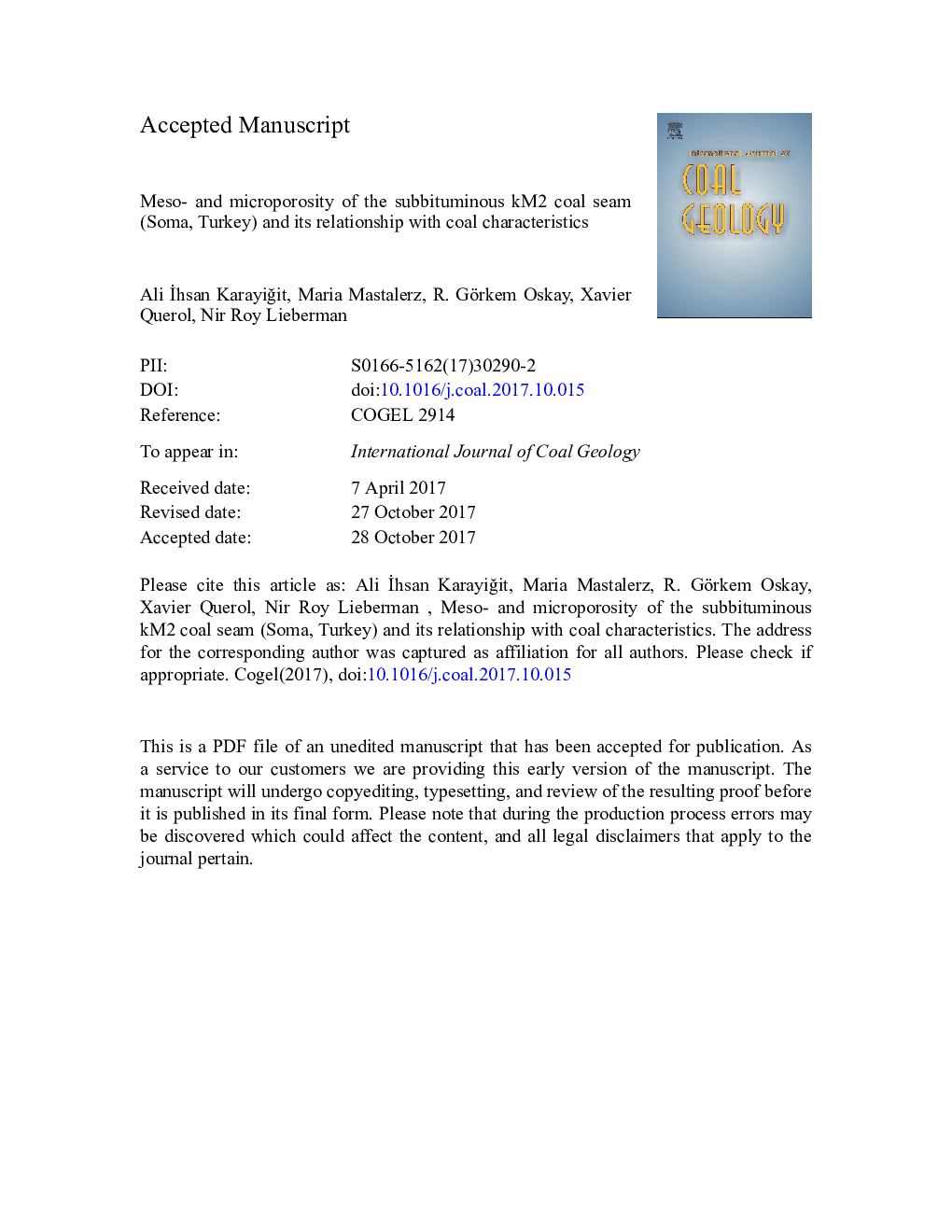| کد مقاله | کد نشریه | سال انتشار | مقاله انگلیسی | نسخه تمام متن |
|---|---|---|---|---|
| 8123654 | 1522519 | 2017 | 46 صفحه PDF | دانلود رایگان |
عنوان انگلیسی مقاله ISI
Meso- and microporosity of the subbituminous kM2 coal seam (Soma, Turkey) and its relationship with coal characteristics
دانلود مقاله + سفارش ترجمه
دانلود مقاله ISI انگلیسی
رایگان برای ایرانیان
کلمات کلیدی
موضوعات مرتبط
مهندسی و علوم پایه
علوم زمین و سیارات
زمین شناسی اقتصادی
پیش نمایش صفحه اول مقاله

چکیده انگلیسی
This study focuses on meso- and microporosity of the subbituminous kM2 coal seam and its relation to coal characteristics. The coal seam is being mined in an underground coal mine at the Eynez sector in the Soma Basin (Western Turkey). The analysed coal samples are characterized by low moisture (avg. 8.2%, on air-dry basis) and total S content (avg. 1.5%, on dry basis), and moderate ash yield (avg. 26.1%, on dry basis). The predominant maceral group is huminite, in which telohuminite is the dominant maceral subgroup (up to 57.1Â vol.%, on whole-coal basis), whereas liptinite and inertinite maceral groups occur in low but variable proportions. Mineralogically, the samples are composed of quartz, clay minerals (kaolinite and illite), carbonates, pyrite, and rarely feldspars and gypsum. Statistical and SEM-EDX analyses indicate that the majority of elements have inorganic affinity, particularly the aluminosilicate minerals. The specific surface area and volume of mesopores, and average mesopore size determined by low pressure N2 adsorption, range widely throughout the studied seam section. Micropore characteristics, analysed by low-pressure CO2 adsorption, demonstrate that micropores are abundant, and specific surface area and volume of micropores vary widely. Surface area and volume of mesopores are slightly higher in the lower part of the seam, whereas the opposite was observed for surface area and volume of microspores. These trends may imply that hydrostatic pressure has little impact upon mesopore characteristics, although increased ash yields in the lower part of the seam suggest that minerals are the major contributor of coal mesopores. Furthermore, total C contents and huminite macerals, particularly telohuminite, display positive correlations with micropore characteristics. Thus, the variations in the microporosity are mainly correlated with the proportion of organic matter (macerals) in the analysed samples. The contents of aluminosilicate-affiliated elements display moderate to strong positive correlations with surface area and volume of mesopores, and total S and B contents display weak positive correlations with surface area and volume of micropores. The element B likely precipitated from porewater or intra-seam solutions during coalification and was absorbed by macerals having abundant microporosity. The abundance of micropores along with frequent disseminated pyrite crystals within the reactive macerals (telohuminite group) and higher total S contents in the upper parts of the seam could increase the risk of self-heating. Therefore, care should be taken to use caution when mining the upper part of the seam.
ناشر
Database: Elsevier - ScienceDirect (ساینس دایرکت)
Journal: International Journal of Coal Geology - Volume 184, 1 November 2017, Pages 73-87
Journal: International Journal of Coal Geology - Volume 184, 1 November 2017, Pages 73-87
نویسندگان
Ali Ä°hsan KarayiÄit, Maria Mastalerz, R. Görkem Oskay, Xavier Querol, Nir Roy Lieberman,